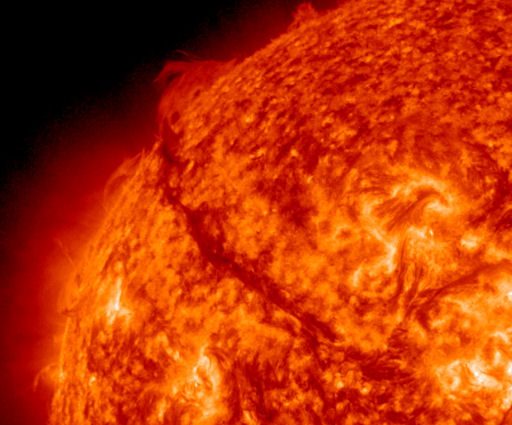Metallic photos of the sun by renowned photographer Greg Piepol bring together the best of art and science. Buy one or a whole set. They make a stellar gift. | | | CME IMPACT: As predicted, a coronal mass ejection (CME) hit Earth's magnetic field on Nov. 12th at approximately 0600 UT. The impact caused ground currents in Norway and a brief flurry of auroras around the Arctic Circle, but otherwise had little effect. No big geomagnetic storms are in tthe offing. Aurora alerts: text, voice. GRAND FILAMENT: A filament of magnetism more than 700,000 km long is curling around the sun's northeastern limb. NASA's Solar Dynamics Observatory photographed the vast structure during the early hours of Nov. 12th: 
The filament is weighted down by solar plasma. If it erupts--as such filaments are prone to do--it could fall to the stellar surface below, setting off an explosion called a Hyder flare. Or it might fly upward, hurling fragments of itself into space. Amateur astronomers with solar telescopes are encouraged to monitor the region for developments. The only challenge will be fitting the whole thing into a single field of view. Solar flare alerts: text, voice. more images: from Lyrics Some of Shiqi, Panyu, Guangzhou, China; from John Nassr of Baguio, Philippines; from Alan Friedman of Buffalo, NY; from Ted Adachi of Montreal, Quebec, Canada SKY COLORS: Auroras in Nebraska are rare, but who needs auroras when you've got iridescence? University of Nebraska freshman Evan Ludes took this picture of cloud-colors over Omaha on the morning of Nov. 10th: 
"I walked out of class this morning and was greeted by one of the best iridescence displays I've ever seen!" says Ludes. "The colors formed on the leading edge of a long stretch of cirrocumulus clouds." Iridescent colors appear when sunlight shines through water droplets in the edges of clouds. The mechanism is diffraction. The colors are at their brightest and most distinct when the droplets are small and uniformly-sized. "I'm no optics expert," says Ludes, "but I'm guessing the colors were particularly vivid since these clouds were newly formed and therefore likely had water droplets of similar shape and size. It was incredible how distinct the bands of colors were even when zoomed in at 300mm!" Potentially Hazardous Asteroids ( PHAs) are space rocks larger than approximately 100m that can come closer to Earth than 0.05 AU. None of the known PHAs is on a collision course with our planet, although astronomers are finding new ones all the time. On November 12, 2011 there were 1256 potentially hazardous asteroids. Recent & Upcoming Earth-asteroid encounters: | Asteroid | Date(UT) | Miss Distance | Mag. | Size | | 2011 FZ2 | Nov 7 | 75.9 LD | -- | 1.6 km | | 2005 YU55 | Nov 8 | 0.8 LD | 11.2 | 400 m | | 2011 UT91 | Nov 15 | 9.9 LD | -- | 109 m | | 1994 CK1 | Nov 16 | 68.8 LD | -- | 1.5 km | | 1996 FG3 | Nov 23 | 39.5 LD | -- | 1.1 km | | 2003 WM7 | Dec 9 | 47.6 LD | -- | 1.6 km | | 1999 XP35 | Dec 20 | 77.5 LD | -- | 1.0 km | | 2000 YA | Dec 26 | 2.9 LD | -- | 80 m | | 2011 SL102 | Dec 28 | 75.9 LD | -- | 1.1 km | Notes: LD means "Lunar Distance." 1 LD = 384,401 km, the distance between Earth and the Moon. 1 LD also equals 0.00256 AU. MAG is the visual magnitude of the asteroid on the date of closest approach. | | The official U.S. government space weather bureau | | | The first place to look for information about sundogs, pillars, rainbows and related phenomena. | | | Researchers call it a "Hubble for the sun." SDO is the most advanced solar observatory ever. | | | 3D views of the sun from NASA's Solar and Terrestrial Relations Observatory | | | Realtime and archival images of the Sun from SOHO. | | | from the NOAA Space Environment Center | | | the underlying science of space weather | | 
